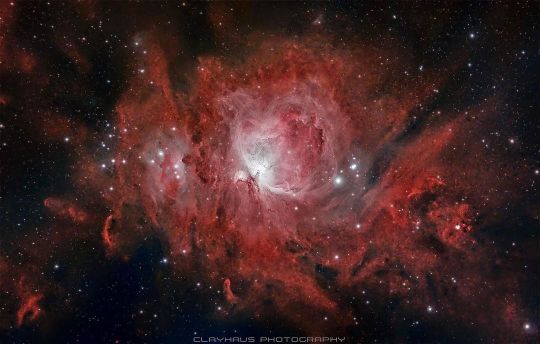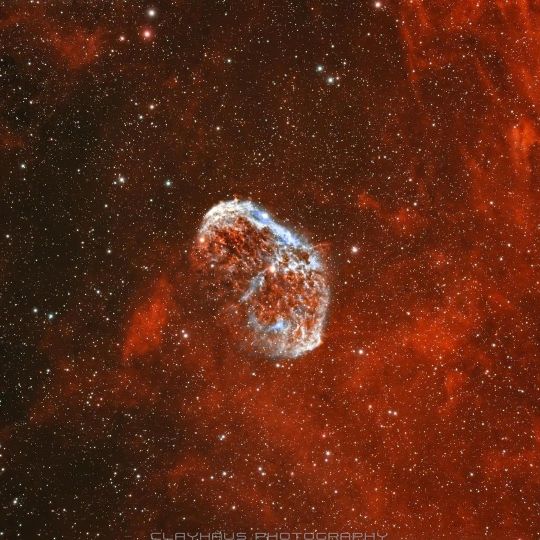#astropixelprocessor
Explore tagged Tumblr posts
Text

#IFTTT#Flickr#spaghettinebula#mosaic#astrophotography#sh2240#longexposure#foraxx#asi2600mm#zwo#am5#nebula#telescope#astropixelprocessor#sho#usa#ed80#explorescientific#pixinsight
8 notes
·
View notes
Text

Iris Nebula
NGC 7023, known as the Iris Nebula, is an area of brownish dark dust in the Cepheus constellation - illuminated brilliantly in the centre by an intensely bright, blue young star SAO 19158. According to NASA, this area attracts study because of its unusual prevalence of Polycyclic Aromatic Hydrocarbons (PAHs), complex molecules found on Earth during the incomplete combustion of wood fires.
My picture comprises 746 x 20" exposures at ISO 1600, imaged from Colchester, England, on a modified Nikon D750 DSLR, Sky-Watcher Explorer 150p, EQ5 Pro, via Stellarmate in Kstars/Ekos. Stacked in AstroPixelProcessor, cropped and adjusted in Photoshop and Lightroom.
2 notes
·
View notes
Photo

Last night’s target was a galaxy far far away: NGC 6946, the Fireworks Galaxy. This galaxy located about 25 million light years away is an active starburst galaxy. The blue and the magenta that you see in the arms of this galaxy are star formation regions. Remarkably, finally last night we had clear skies and my telescope was able to take 25-five minute exposures, uninterrupted (except for a scheduled meridian flip at about 11:40). Even more remarkably every single exposure was tack sharp. Processed with Astro pixel processor and Photoshop. #Galaxy #Space #AstroPhotography #clayhausphotography #AstroPhotographer #Celestron #ZWO #astropixelprocessor https://www.instagram.com/p/CEcqbQrBh_x/?igshid=1745sbh2t5c9p
#galaxy#space#astrophotography#clayhausphotography#astrophotographer#celestron#zwo#astropixelprocessor
1 note
·
View note
Photo

Heart Nebula - Reprocess . My wife @ruthanneplus7 hates that my images are always red so when I saw @north.stargazer post he was using APP to extract Ha and Oiii channels from color data captures using a dual band filter I had to bug him for the details and then try it out myself. I watched two different videos, made a lot of bad choices throughout the day and eventually got this result on my Heart Nebula data around midnight last night. This whole process is a work in progress, and probably will be for a while but I like the ability to bring out different colors which I feel draws out different, and sometimes more detail . 127x180s over threw nights plus calinration frames . @meadeinstruments Series 6000 80mm Triplet APO @sky_watcher_official EQ6-R Pro @canonusa EOS Ra Astro-Tech 0.8 Reducer @optolongfilter L-eNhanced filter Stacked and initial processing in Astro Pixel Processor (APP), final processing in Photoshop and starnet++ for the starless . . . #astronomy #astrophotography #astrophoto #highpointscientific #hpscollections #IAmSkyWatcher #earliestlight #heartnebula #ic1805 #photooftheday #photography #apod #amateurphotography #Science #space #nightsky #astropixelprocessor #nebula #meadeinstruments #canonphoto #canonusa #igworldclub_astrophotography #ig_astrophotography #narrowband #spacephoto #NASA #rhodeisland #milkyway #cosmos (at Providence, Rhode Island) https://www.instagram.com/p/CJqabdapQdq/?igshid=tfbv3917imnu
#astronomy#astrophotography#astrophoto#highpointscientific#hpscollections#iamskywatcher#earliestlight#heartnebula#ic1805#photooftheday#photography#apod#amateurphotography#science#space#nightsky#astropixelprocessor#nebula#meadeinstruments#canonphoto#canonusa#igworldclub_astrophotography#ig_astrophotography#narrowband#spacephoto#nasa#rhodeisland#milkyway#cosmos
0 notes
Photo

#Repost @astrononico with @get_repost ・・・ Kind of a Cosmic Selfie! The galaxy NGC2903 captured with a focal length of more than 2 meters! 😮😀✨ This, often overlooked beauty is about 20.5 million light-years away and just a little smaller than the #MilkyWay. Also its spiral structure and central bar are very comparable to our own #galaxy. This is the result of the first deep-space test for my #EdgeHD8 and also my deepest astrophotography yet - challenging but satisfying 😊 — Some details: - scope Celestron #EdgeHD 800 (2125mm, f/10) - imaging cam ZWO #ASI294MC Pro - mount #iOptron #CEM25P - guide scope 50mm SVBony f/3.8 - guide cam #ASI120MC-S - 82x120sec (gain240 at -20°C) - calibrated in #AstroPixelProcessor (50 flats, 50 dark flats , 30 darks) - registered and integrated in #PixInsight - finished with PixInsight and #Photoshop (and #StarSpikesPro for a little icing on the cake ☺️) — #amateurastrophotography #astronomy #astrophotography #space #astro #cosmos #deepspace #telescope #natgeospace #astrophysics #universe #StellarMate #deepsky #igworldclub_astrophotography #amateurastrophotographyezine https://www.instagram.com/p/B_NHmpen0Dw/?igshid=1krwvg6pukyyb
#repost#milkyway#galaxy#edgehd8#edgehd#asi294mc#ioptron#cem25p#asi120mc#astropixelprocessor#pixinsight#photoshop#starspikespro#amateurastrophotography#astronomy#astrophotography#space#astro#cosmos#deepspace#telescope#natgeospace#astrophysics#universe#stellarmate#deepsky#igworldclub_astrophotography#amateurastrophotographyezine
0 notes
Photo

Regrann from @yat.sze - Magnitude 10.2 Hamburger Galaxy or Sarah's Galaxy is an unbarred spiral galaxy about 100,000 light years across that is part of the Leo Triplet, located at a distance of 35 million light years away in the constellations Leo. . The image shows a puffy galactic disk with a broad equatorial and obscuring band of dust spanning approximately 300,000 light years. . This is my fourtheen galaxy captured this season and probably the most difficult capture due to the faintest magnitude 10.2 and the lower constellation Leo in the sky from my location. . 50x3 mins lights, 20 darks, 20 flat, 20 bias #asi224mc 150/0.63x1500mm f/6.3 #celestronc6 #celestronavx #phd2guiding #astropixelprocessor #affinityphoto . #ngc3628 #hamburgergalaxy #sarahsgalaxy #Leoconstellation #messierobject #ottawagalaxy #ottawasky #ottawaastronomy #ottawaastrophotography #astrophotography #astrophoto #deepskyobject #universetoday - #regrann
#sarahsgalaxy#phd2guiding#astrophotography#astropixelprocessor#regrann#celestronavx#celestronc6#ngc3628#ottawagalaxy#ottawasky#ottawaastronomy#ottawaastrophotography#astrophoto#universetoday#affinityphoto#messierobject#leoconstellation#hamburgergalaxy#asi224mc#deepskyobject
0 notes
Video
Eagle Nebula / M16 / NGC 6611 (Extract) by Mark James Ford Via Flickr: Eagle Nebula / M16 / NGC 6611 (Extract from full image) H-alpha, S-II narrowband and photometric i’ (700-850nm) filters Taking with the SIGMA fp (monochrome) / SIGMA fp L / Celestron RASA 11" / 10 Micron GM1000 Mount. Total acquisition time ca. 3 hrs, ISO 1600, F2.2, 620mm Registration in AstroPixelProcessor further processing to taste in Photoshop. Full Image: markjamesford.prodibi.com/a/rd6jv5qzrx67079/i/9zjdxw296k4...
#eaglenebula#deepskyobject#deepskyphotography#m16#ngc6611#sigmafpmonochrome#sigmafpl#celestronrasa11#10microngm1000#markjamesford#astrophotography#beautyinallthings#beautyinnature#aweinspiringnature#flickr
0 notes
Text

Tulip Nebula
The Tulip Nebula, catalogued as Sharpless 101 (Sh2-101), is an emission nebula in the constellation Cygnus. My picture comprises almost 700 x 20” exposures at ISO 1600, imaged from Colchester, England, on a modified Nikon D750 DSLR, Sky-Watcher Explorer 150p, EQ5 Pro, via Stellarmate in Kstars/Ekos. Stacked in AstroPixelProcessor, cropped and adjusted in Photoshop and Lightroom.
2 notes
·
View notes
Text

The Western Veil with the bright foreground star 52 Cygni, and (lower left) Pickering's Triangle. My picture comprises just over 1500 x 20” exposures at ISO 1600, imaged from Colchester, England, a few days ago on a modified Nikon D750 DSLR, Sky-Watcher Explorer 150p, EQ5 Pro, via Stellarmate in Kstars/Ekos. Stacked in AstroPixelProcessor, cropped and adjusted in Photoshop and Lightroom.
2 notes
·
View notes
Text

This is the Crescent Nebula in the constellation of Cygnus, photographed over four nights in May 2023. NGC 6888 is the result of the outer layers of the old star at its centre - known as a Wolf-Rayet star - being blasted out by a powerful stellar wind. The shape that we see is about 25 light years across and 5,000 light years away from Earth.
My picture involved 9.5 hours of sub-exposures plus calibration frames, taken in Colchester, England, on a modified Nikon D750 DSLR, Sky-Watcher Explorer 150p, EQ5 Pro, via Stellarmate in Kstars/Ekos. Stacked in AstroPixelProcessor, cropped and adjusted in Photoshop and Lightroom.
3 notes
·
View notes
Photo

M42 Orion Nebula
It’s been far too long after my last post, I have been using my equipment when the weather allows, however, been very bad ay posting here, something I will improve upon.
After many months of struggling to get my equipment to work remotely, I think the system is now working reliably, unfortunately, the Moon was hanging nearby for my test subject on 26/02/21.
On this night the mount was working fairly well, although guiding was still causing some issues. These issues I think are to do with backlash, to hopefully overcome this I have modified the mount with a belt driven kit (http://www.rowanastronomy.com/productsa1.htm#heq5beltkit). The instructions are good and it’s easy to fit, plenty of videos on YouTube also. The mount is really quiet when tested during the day and hopefully this week I will get some clear skies to test it properly.
I'm not 100% with this image of M42 yet, still getting used to Astropixel Processor and post-production with my own images but I thought I would post anyway. Images: 50 x 12 sec Red 50 x 12 sec Green 50 x 12 sec Blue Total integration time: 30 minutes
Calibration files 100 darks 100 bias 100 flats Stacked in AstroPixelProcessor Processing in AstroPixelProcessor
Equipment: Telescope: Skywatcher 120ED Pro Focal reducer: Skywatcher 0.85x reducer/field flattener Mount: Skywatcher HEQ5 Pro Camera: Atik 314L+ Mono cooled to Temp degrees Focuser: PrimaLuceLab ESATTO2 Guidescope: PrimaLuceLab 60mm Guide camera: ZWO 120mm mono Controller: PrimaLuceLab Eagle 2 Sequencing software: N.I.N.A.
#m42#heq5pro#skywatcher#120ed#atik#314L+#astropixelprocessor#app#nebula#Nebulosity#Night Sky#winter#astrophotography#astronomical#astro#cosmos#orion
2 notes
·
View notes
Photo

More grey skies with rain and snow equals more opportunity to re-visit old astro-data. In this case, M 42 | Great Orion Nebula & NGC 1977 | Running Man Nebula, captured 4-Dec-21. I've learned some new processing steps and have new software tools at hand, as well. This version of the Orion Nebula explodes with the red of excited hydrogen molecules. The use of a special nebula "booster" filter -- and much processing -- helps bring out the details. For those that might ask, I added no color to the image. In fact, I reduced the saturation so that it looked less like the evidence of a crime scene! (No aliens were harmed in the production of this image!) Tech details: https://www.astrobin.com/ppeaae/ #clayhausphotography #idasnb1 #asi2600mcpro #orionnebula #williamopticszs61 #celestronavx #astropixelprocessor #pixinsight #astrophotography #astronomy https://www.instagram.com/p/CniH5GpPG03/?igshid=NGJjMDIxMWI=
#clayhausphotography#idasnb1#asi2600mcpro#orionnebula#williamopticszs61#celestronavx#astropixelprocessor#pixinsight#astrophotography#astronomy
1 note
·
View note
Photo

Sh2-142, the Wizard Nebula. This emission nebula is a large, diffuse HII region in the constellation Cepheus and is ionized by the binary star DH Cephei, which is the bright star just about centre in the image. This is almost 6 hour's worth of capture image was taken with my Celestron SCT 8" back in mid-October. #clayhausphotography #celestronuniverse #celestronrocks #celestrontelescope #astrophotography #pixinsight #blurxterminator #astropixelprocessor https://www.instagram.com/p/CmaRb7YPSE_/?igshid=NGJjMDIxMWI=
#clayhausphotography#celestronuniverse#celestronrocks#celestrontelescope#astrophotography#pixinsight#blurxterminator#astropixelprocessor
0 notes
Photo

I need to get back to Vietnam -- photographically speaking -- but here is one more astrograph that I captured in early September, but just now processed. It is a wide-field, 5 hour capture of Sh2-101, the Tulip Nebula (upper-centre) and some nearby nebulosity. The Tulip Nebula is about 6000 light years distant in the constellation Cygnus. #clayhausphotography #astropixelprocessor #pixinsight #astrophotographer #astrophotography #astrograph https://www.instagram.com/p/Cj36tHVPdgc/?igshid=NGJjMDIxMWI=
0 notes
Photo

Sh2-129, the Flying Bat Nebula, Is a huge Hii nebula located in the constellation Cepheus, the King. If you Google this object, and I do encourage you to do so, you will likely see images with a pale blue cylindrical nebula embedded in the field of red. That is the recently discovered Squid nebula. It takes many more hours than the five hours of integration time I have gathered here as well as different equipment to expose that elusive nebula. You see no hint of it here. In the center of this red field you do see a bright white star which is actually the triple star system that is igniting and driving all of this nebulosity. This is an object I will surely return to together even more data. And perhaps with the right equipment attempt to resolve the Squid nebula. #clayhausphotography #nebula #williamopticsz61 #asi2600mcpro #astropixelprocessor #pixinsight #astrophotography #astrophotographer #astronomy https://www.instagram.com/p/CinG5EBLXWa/?igshid=NGJjMDIxMWI=
#clayhausphotography#nebula#williamopticsz61#asi2600mcpro#astropixelprocessor#pixinsight#astrophotography#astrophotographer#astronomy
0 notes
Photo

At the end of August and beginning of September we had a very nice stretch of clear, windless nights with pretty good seeing and transparency. For nine nights I had two telescopes capturing those elusive but ever-present photons from afar. Here we have NGC 6888, the Crescent Nebula, with 5.5 hours of acquisition time. The central star of this interesting nebula is classified as a Wolf-Rayet star. These types of stars are known for generating fierce stellar winds as they shed their outer envelopes of gases. The complex and unique structure of this nebula is likely the result of these stellar winds. NGC 6888 is burning through its fuel at a prodigious rate and will ultimately ignite in a spectacular supernova explosion. #clayhausphotography #astropixelprocessor #pixinsight #nebula #astrophoto #astrophotographer #astrophotography #astronomy #asiairpro #asi533mcpro #explorescientific https://www.instagram.com/p/CiUB4qjOObF/?igshid=NGJjMDIxMWI=
#clayhausphotography#astropixelprocessor#pixinsight#nebula#astrophoto#astrophotographer#astrophotography#astronomy#asiairpro#asi533mcpro#explorescientific
0 notes